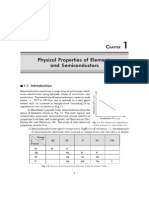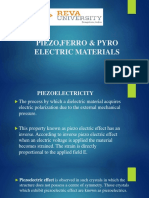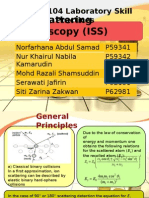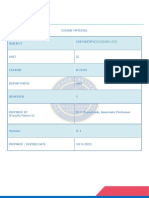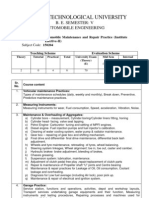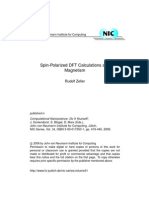Surface Engineering of Nanomaterials: Lecture 12: Physical Vapour Deposition (PVD)
Uploaded by
hrana287Surface Engineering of Nanomaterials: Lecture 12: Physical Vapour Deposition (PVD)
Uploaded by
hrana287SURFACE ENGINEERING OF NANOMATERIALS
Lecture 12: Physical Vapour Deposition (PVD)
Dr. Kaushik Pal
Associate Professor
Dept. of Mech. & Indl. Engg.
Joint faculty: Centre of Nanotechnology
Introduction:
PVD involves physical ejection of material as atoms or molecules; and condensation and
nucleation of these atoms onto a substrate.
The vapor phase material can consist of ions or plasma and is often chemically reacted
with gases introduced into the vapor, called reactive deposition, to form new compounds.
These processes can be applied to various kinds of
ceramic, polymers, alloys and composites etc.
ADVANCED COMPOSITE LAB 2
Classification of PVD:
Thermal Evaporation
Physical Vapor Deposition
Electron Beam (e-beam) Evaporation
Reactive /Activated Reactive Electron Beam Evaporation
Sputtering
Filtered Cathodic Arc Deposition
Ion Plating
Pulsed Laser Deposition
ADVANCED COMPOSITE LAB 3
Thermal Evaporation:
Process:
A thermal evaporator uses an electric resistance heater to melt the
source material and raise its vapor pressure to a useful range.
Thermal energy is imparted to atoms in a liquid or solid source so that
it can efficiently evaporate.
Evaporation takes place in vacuum (generally, 10-4 to 10-6 Torr).
Evaporated particles can travel directly to the deposition target
without colliding with the background gas.
Films can also be co-evaporated using multiple sources.
Types of thermal evaporation according to input energy:
Laser
Direct Indirect
Inductive ablation/
resistive resistive
heating laser
heating heating
evaporation
ADVANCED COMPOSITE LAB 4
1. Direct resistive heating:
• Evaporation materials direct evaporated by high electric current.
• These materials can be in the shape of wire or rods.
• It is limited to few materials e.g. C, Cr, Fe, Mo, Ni, Pd, Rh, Ti, Al.
2. Indirect resistive heating:
• The evaporation material is put into a container (called "boat"),
spiral wire, ribbon or crucible.
3. Inductive heating:
• The evaporated material is heated by high or low frequency induction.
• The evaporated material has to be conductive.
4. Laser evaporation/ Laser ablation:
• The continuous interaction of laser radiation with matter can lead
to thermal evaporation.
• In alternative mechanisms, particles may be released from the solid
due to low pulse duration and high power density of incident
radiation.
ADVANCED COMPOSITE LAB 5
Optimization:
Advantages:
• Purity of the film depends on the purity of the
Simple and cheap
source material and the quality of the vacuum
Less surface damage of the substrate
• In case of films, the thickness of film vary
Excellent purity of films
according to the geometry of chamber
Disadvantages: Applications:
Limited to low melting point metals Evaporation of metals, alloys,
Poor density and adhesion semiconductors, insulators etc.
It’s not possible to evaporate the dielectric Gold plating machine
materials Thermal insulation coatings
Filament limits the amount of materials that
can be deposited
Step coverage is more difficult to improve
Thermal insulator coating
ADVANCED COMPOSITE LAB 6
Electron Beam (e-beam) Evaporation:
Process:
A target anode is bombarded with an electron beam given off by
a charged tungsten filament under high vacuum.
Atoms from the target transform into the gaseous phase due to
the electron beam.
These atoms then precipitate into solid form by coating the
substrate with a thin layer of the anode material.
Advantages: Applications:
High (few μm/min) as well as low (1 nm/min) deposition rate. Aerospace, Cutting and Tool
Ability to control structural and morphological properties of industries, Electronic & Optical
films for semiconductor industries.
films.
Disadvantages:
Filament degradation due to a non-uniform evaporation rate.
Significant scattering of the vapor cloud takes place.
ADVANCED COMPOSITE LAB 7
Reactive and Activated Reactive Electron Beam Evaporation:
Purpose of reactive and activated reactive electron beam:
Certain refractory oxides and carbides undergo fragmentation during electron beam evaporation,
resulting in stoichiometry which is different from initial material.
To overcome this situation, reactive/activated reactive evaporation are employed.
Both e-beam and thermal evaporation processes are used for reactive/activated reactive deposition.
Advantages: Deposition of oxides (compounds)
Reactive type:
In this process, the reactive gas (O2, N2, Hydrocarbon) is
introduced into the chamber while the metal is evaporated.
When the thermodynamic conditions are met, the metal atoms
react with the gas in the vicinity of the substrate to form films. Reactive evaporation process
of Al with oxygen gas
ADVANCED COMPOSITE LAB 8
Activated Reactive type (ARE):
This process is two-fold:
To enhance the reaction efficiency through activation of the
reactive gas that are necessary for deposition of compound films.
To modify the growth kinetics and hence the
structure/morphology of the deposits.
Plasmas are also used to activate the reactive gas.
Its evaporation sources may be
• e-beam evaporation source
• A resistance-heated source.
Recent developments in the ARE process
1. To produce the vapor species.
2. Confinement of evaporation techniques and development Carbide coated cutting tools
of modified plasma excitation geometries.
Applications:
TiO2, SiO2 as optical coatings
Manufacturing of Carbides and Nitrides (TiC, TiN).
ADVANCED COMPOSITE LAB 9
Sputtering:
• Steps for sputtering process:
1. Target material and substrate is placed in a vacuum chamber.
2. A voltage is applied between target (cathode) & substrate (anode).
3. A plasma is created by ionizing a sputtering gas (generally a
chemically inert, heavy gas like Argon).
4. Atoms/molecules of target material are ejected into a gas form or
plasma due to bombardment of sputtering gas.
5. Ejected target materials deposited onto the substrate.
• For efficient momentum transfer, the atomic weight of the sputtering
gas (Ar, Ne, Kr, Xe) should be close to the atomic weight of the target.
Advantages:
Materials having high melting points can be easily sputtered.
Films by sputtering have a better adhesion on the substrate than evaporated films.
Disadvantages:
Inert sputtering gases are built into the growing film as impurities.
ADVANCED COMPOSITE LAB 10
Comparison between Evaporation and Sputtering processes:
Evaporation Sputtering
Low energy atom (0.1 eV) High energy atom/ ions (1-10 eV)
• Denser film
• Smaller grain size
• Better adhesion
High vacuum Low vacuum
• Directional, good for lift-off • Poor directionality, better step coverage
• Lower impurity • Gas atom implanted in the film
Point source Parallel plate source
• Poor uniformity • Better uniformity
Component evaporate at different rate All component sputtered with similar rate
• Poor stoichiometry • Maintain stoichiometry
ADVANCED COMPOSITE LAB 11
Cathodic Arc Deposition:
An electric arc is used to vaporize material from
target cathode. Vaporized material then condenses on a
substrate, forming a thin film.
Cathodic arcs take a special place among PVD
processes because of high ion densities.
Cathodic arc deposition process
Arc vaporization occurs when a high current (low
voltage) is passed through a source material placed
Issues faced by the cathodic arc
between two electrodes (anode and cathode).
process:
This process produces extremely hard films therefore • Poor film quality
can be used for thin hard-film, super hard • Uniformity in thickness
coatings or nanocomposite coatings. • Poor arc control
• Poor repeatability & reliability for
It can be used to deposit metallic, ceramic, production processes
and composite films. • High maintenance
ADVANCED COMPOSITE LAB 12
Filtered Cathodic Arc Deposition:
The filtered cathodic arc (FCA) process is extensively used
to deposit tribological and wear resistant thin films.
Mainly, it eliminates the macroparticles that degrade coating
performance.
Ejected particles are fed into a curved duct having a focusing
magnetic field and a steering field which separates the
particles by mass, thus "filtering" them (like a mass
spectrometer).
Unwanted macroparticles and neutral atoms are filtered out
by mechanical filters, and coating species reaching the
substrate are pure ions. Filtered cathodic arc deposition
process
The beam of particles must be rastered over the substrate to
coat large areas with acceptable uniformity.
ADVANCED COMPOSITE LAB 13
Ion Plating:
It is an atomistic vacuum coating process where depositing film is
continuously or periodically bombarded by energetic atomic-sized inert
or reactive particles.
It is also called as ion assisted deposition (IAD) or ion vapor
deposition (IVD).
Activated reactive evaporation (ARE) process with a negative bias on
the substrate is called reactive ion plating.
The source of depositing atoms can be from vacuum evaporation,
sputtering, arc vaporization or from a chemical vapor precursor.
Mechanism of Ion-plating: Evaporation Sputtering Arc vaporization
1. Surface preparation
2. Nucleation and interface formation
3. Film growth.
Sources of depositing atoms
ADVANCED COMPOSITE LAB 14
Types of ion-plating process:
1. Plasma based ion plating: Bombarding species are generally
accelerated ion from a plasma.
2. Vacuum based ion-plating: Bombarding species are accelerated
ions from an ion source in vacuum chamber. Plasma based ion plating
Advantages:
Compatible with any PVD and many CVD processes.
Most advanced surface finishing process.
This process makes the gold or other metal coating more
durable, more wear resistant and higher brightness.
Vacuum based ion plating
Possibility of high density films.
Excellent adhesion of films to the substrate. Disadvantages:
Possibility of unwanted substrate heating
Introduced by plasma bombardment
ADVANCED COMPOSITE LAB 15
Pulsed Laser Deposition (PLD):
A high-power pulsed laser is focused on the target which is ablated
to form a plume of atoms, molecules, and particulates directly
towards the substrate.
It can work under controlled gas environment (both inert and
reactive)
Mechanism of PLD:
The mechanism of the PLD process can be expressed in three steps:
• The interaction of the laser beam and target.
• Plasma plume formation
• Nucleation and growth of thin film
Some factors that influence the deposition rate:
• Target material
• Pulse energy of laser
• Distance from target to substrate
• Type of gas and pressure in chamber (oxygen, argon, etc.)
ADVANCED COMPOSITE LAB 16
Benefits over other film deposition methods: Disadvantages:
• Fast response, well controlled deposition rate. • High defect or particulate
• Relatively high deposition rates (~100s Å/min). concentration.
• Growth in any environment. • Uneven coverage.
• Flexible, easy to implement. • Not well suited for large scale film
• Reproduce the composition of the target. growth.
• Used to deposit Multilayer films. • PLD does not fit every application.
• Deposition of highly crystalline films.
Applications:
Dielectric and ferroelectric films
Optical and tribological coatings
Semiconductors
Architectural structures
Window glazing
Vacuum web coating
Wear resistant coatings
ADVANCED COMPOSITE LAB 17
Summary:
In PVD, chemical reaction are not involved except for reactive sputtering
deposition.
The main advantages of PVD are
• Controllable growth of thin films with high purity.
• Ability to control structural and morphological properties of films.
• Improvement in repeatability and reliability of the modified substrate.
• In most cases, instruments are highly precise as well as cost effective.
Modification techniques can be applied in various fields like manufacturing of
semiconductor devices, optical coatings, tribological coatings, aerospace
industries etc.
ADVANCED COMPOSITE LAB 18
ADVANCED COMPOSITE LAB 19
You might also like
- Ava Bagley - Exploring - Motion - GraphsNo ratings yetAva Bagley - Exploring - Motion - Graphs4 pages
- 5 Reflection High Energy Electron Diffraction (RHEED)No ratings yet5 Reflection High Energy Electron Diffraction (RHEED)19 pages
- Kronig Penny Model: Engineering Physics by Dr. Amita Maurya, Peoples University, Bhopal. Unit 5No ratings yetKronig Penny Model: Engineering Physics by Dr. Amita Maurya, Peoples University, Bhopal. Unit 57 pages
- Two Dimensional Electron Gas System (2DEG)No ratings yetTwo Dimensional Electron Gas System (2DEG)16 pages
- C Physical Properties of Elements and Semiconductors: Hapter100% (1)C Physical Properties of Elements and Semiconductors: Hapter96 pages
- Ferroelectricity: Spontaneous Dipole Moment100% (2)Ferroelectricity: Spontaneous Dipole Moment24 pages
- Rutherford Backscattering Spectroscopy (RBS)No ratings yetRutherford Backscattering Spectroscopy (RBS)23 pages
- Presentation1 090415045351 Phpapp01 - 2No ratings yetPresentation1 090415045351 Phpapp01 - 224 pages
- 271 - PH8252 Physics For Information Science - Notes UNIT IV OPTICAL PROPERTIES OF MATERIALS PDF100% (1)271 - PH8252 Physics For Information Science - Notes UNIT IV OPTICAL PROPERTIES OF MATERIALS PDF66 pages
- (#3) Direct, Indirect, Ek Diagram, Effective Mass-1No ratings yet(#3) Direct, Indirect, Ek Diagram, Effective Mass-16 pages
- Unit-III Dielectrics, Magnetic & EnergymaterialsNo ratings yetUnit-III Dielectrics, Magnetic & Energymaterials26 pages
- Double-Exchange Interaction and Orbital OrderingNo ratings yetDouble-Exchange Interaction and Orbital Ordering32 pages
- Electrical Properties of Semiconductors PDF100% (1)Electrical Properties of Semiconductors PDF2 pages
- Energy Bands For Electrons in Crystals (Kittel Ch. 7)No ratings yetEnergy Bands For Electrons in Crystals (Kittel Ch. 7)39 pages
- Rheed & Leed: Presented By-Mohammad Rameez Devika LaishramNo ratings yetRheed & Leed: Presented By-Mohammad Rameez Devika Laishram42 pages
- Lecture 4 Heisenberg Equation of MotionNo ratings yetLecture 4 Heisenberg Equation of Motion15 pages
- Advanced Electrochemistry - PPT - FYBtechNo ratings yetAdvanced Electrochemistry - PPT - FYBtech26 pages
- Module 4 Electrical Conductivity in Metals and Superconductivity 22phys12 NPNo ratings yetModule 4 Electrical Conductivity in Metals and Superconductivity 22phys12 NP21 pages
- Homo and Hetero Junction Semiconductor Diode LasersNo ratings yetHomo and Hetero Junction Semiconductor Diode Lasers9 pages
- Unit 5 - Engg Physics NEP Superconductors and Nano100% (1)Unit 5 - Engg Physics NEP Superconductors and Nano9 pages
- UNIT I and II - ESSAY AND SHORT QUESTIONS PDFNo ratings yetUNIT I and II - ESSAY AND SHORT QUESTIONS PDF8 pages
- Process of Fabricating Nano-Surface Coating and Methods of Testing Their PropertiesNo ratings yetProcess of Fabricating Nano-Surface Coating and Methods of Testing Their Properties36 pages
- MA505-N-C Modern Manufacturing ProcessesNo ratings yetMA505-N-C Modern Manufacturing Processes3 pages
- Surface Engineering of Nanomaterials: Lecture 11: Deposition and Surface Modification MethodsNo ratings yetSurface Engineering of Nanomaterials: Lecture 11: Deposition and Surface Modification Methods19 pages
- Surface Engineering of Nanomaterials: Lecture 01: Tribology & Its ClassificationNo ratings yetSurface Engineering of Nanomaterials: Lecture 01: Tribology & Its Classification19 pages
- Final Evaluation Sub. EVS Student's Name: Roll No.: Q. 1 Answer in One WordNo ratings yetFinal Evaluation Sub. EVS Student's Name: Roll No.: Q. 1 Answer in One Word3 pages
- Surface Engineering of Nanomaterials: Lecture 02: Friction TribologyNo ratings yetSurface Engineering of Nanomaterials: Lecture 02: Friction Tribology17 pages
- Circular: Kadi Sarva Vishwavidyalaya LDRP Institute of Technology & Research Mechanical Engineering DepartmentNo ratings yetCircular: Kadi Sarva Vishwavidyalaya LDRP Institute of Technology & Research Mechanical Engineering Department4 pages
- ME405 - Mechanical Measurement & MetrologyNo ratings yetME405 - Mechanical Measurement & Metrology3 pages
- Gujarat Technological University: InstructionsNo ratings yetGujarat Technological University: Instructions1 page
- Automobile Maintenance and Repair Practice (Institute IINo ratings yetAutomobile Maintenance and Repair Practice (Institute II2 pages
- H. R. Vallentine (Auth.) - Applied Hydrodynamics-Springer US (1967) PDFNo ratings yetH. R. Vallentine (Auth.) - Applied Hydrodynamics-Springer US (1967) PDF305 pages
- Deformation and Strength of Embankments On Soft Dutch SoilNo ratings yetDeformation and Strength of Embankments On Soft Dutch Soil14 pages
- Black Hole Complementarity and Firewall in Two Dimensions: Wtkim@sogang - Ac.kr Bhl@sogang - Ac.krNo ratings yetBlack Hole Complementarity and Firewall in Two Dimensions: Wtkim@sogang - Ac.kr Bhl@sogang - Ac.kr15 pages
- Prototype and Contextualized Daily Lesson Plan IN Grade 10 Science Matter and Its Interactions100% (2)Prototype and Contextualized Daily Lesson Plan IN Grade 10 Science Matter and Its Interactions226 pages
- Radial Fan Conical Vs Parallel Impeller Casing AnalysisNo ratings yetRadial Fan Conical Vs Parallel Impeller Casing Analysis10 pages
- Bmee207l Kinematics-And-dynamics-Of-machines TH 1.0 67 Bmee207lNo ratings yetBmee207l Kinematics-And-dynamics-Of-machines TH 1.0 67 Bmee207l3 pages
- 5 Reflection High Energy Electron Diffraction (RHEED)5 Reflection High Energy Electron Diffraction (RHEED)
- Kronig Penny Model: Engineering Physics by Dr. Amita Maurya, Peoples University, Bhopal. Unit 5Kronig Penny Model: Engineering Physics by Dr. Amita Maurya, Peoples University, Bhopal. Unit 5
- C Physical Properties of Elements and Semiconductors: HapterC Physical Properties of Elements and Semiconductors: Hapter
- 271 - PH8252 Physics For Information Science - Notes UNIT IV OPTICAL PROPERTIES OF MATERIALS PDF271 - PH8252 Physics For Information Science - Notes UNIT IV OPTICAL PROPERTIES OF MATERIALS PDF
- (#3) Direct, Indirect, Ek Diagram, Effective Mass-1(#3) Direct, Indirect, Ek Diagram, Effective Mass-1
- Energy Bands For Electrons in Crystals (Kittel Ch. 7)Energy Bands For Electrons in Crystals (Kittel Ch. 7)
- Rheed & Leed: Presented By-Mohammad Rameez Devika LaishramRheed & Leed: Presented By-Mohammad Rameez Devika Laishram
- Module 4 Electrical Conductivity in Metals and Superconductivity 22phys12 NPModule 4 Electrical Conductivity in Metals and Superconductivity 22phys12 NP
- Homo and Hetero Junction Semiconductor Diode LasersHomo and Hetero Junction Semiconductor Diode Lasers
- Unit 5 - Engg Physics NEP Superconductors and NanoUnit 5 - Engg Physics NEP Superconductors and Nano
- Process of Fabricating Nano-Surface Coating and Methods of Testing Their PropertiesProcess of Fabricating Nano-Surface Coating and Methods of Testing Their Properties
- Surface Engineering of Nanomaterials: Lecture 11: Deposition and Surface Modification MethodsSurface Engineering of Nanomaterials: Lecture 11: Deposition and Surface Modification Methods
- Surface Engineering of Nanomaterials: Lecture 01: Tribology & Its ClassificationSurface Engineering of Nanomaterials: Lecture 01: Tribology & Its Classification
- Final Evaluation Sub. EVS Student's Name: Roll No.: Q. 1 Answer in One WordFinal Evaluation Sub. EVS Student's Name: Roll No.: Q. 1 Answer in One Word
- Surface Engineering of Nanomaterials: Lecture 02: Friction TribologySurface Engineering of Nanomaterials: Lecture 02: Friction Tribology
- Circular: Kadi Sarva Vishwavidyalaya LDRP Institute of Technology & Research Mechanical Engineering DepartmentCircular: Kadi Sarva Vishwavidyalaya LDRP Institute of Technology & Research Mechanical Engineering Department
- Automobile Maintenance and Repair Practice (Institute IIAutomobile Maintenance and Repair Practice (Institute II
- H. R. Vallentine (Auth.) - Applied Hydrodynamics-Springer US (1967) PDFH. R. Vallentine (Auth.) - Applied Hydrodynamics-Springer US (1967) PDF
- Deformation and Strength of Embankments On Soft Dutch SoilDeformation and Strength of Embankments On Soft Dutch Soil
- Black Hole Complementarity and Firewall in Two Dimensions: Wtkim@sogang - Ac.kr Bhl@sogang - Ac.krBlack Hole Complementarity and Firewall in Two Dimensions: Wtkim@sogang - Ac.kr Bhl@sogang - Ac.kr
- Prototype and Contextualized Daily Lesson Plan IN Grade 10 Science Matter and Its InteractionsPrototype and Contextualized Daily Lesson Plan IN Grade 10 Science Matter and Its Interactions
- Radial Fan Conical Vs Parallel Impeller Casing AnalysisRadial Fan Conical Vs Parallel Impeller Casing Analysis
- Bmee207l Kinematics-And-dynamics-Of-machines TH 1.0 67 Bmee207lBmee207l Kinematics-And-dynamics-Of-machines TH 1.0 67 Bmee207l





